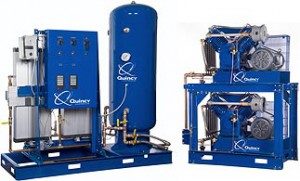Multi-Stage Compressors

Reciprocating/piston compressors use a cylinder to force air into a chamber, where it is compressed. The simplest compressor designs feature a single cylinder/chamber arrangement. While straightforward, this setup is limited in its efficiency and capacity for delivering high volumes of pressurized air.
That’s where multi-stage compressors come in. By increasing the number of cylinder stages, these machines work more effectively and can handle more tools at once.
How Multi-stage Compressors Work
Multi-stage compressors feature a series of cylinders, each of a different diameter. Between each compression stage, the air passes through a heat exchanger, where it is cooled. Cooling the air reduces the amount of work necessary to compress it further.
In a two-stage compressor, air is then forced into an additional chamber where it is pressurized to the required extent. In a three-stage compressor, an additional cycle of compression and cooling occurs before this.
Benefits of Multi-stage Compression
Both single and multi-stage compressors have their benefits. The right one for your application will depend on a number of factors. Specific advantages of a three- or two-stage compressor design include:
- Improved efficiency. Two-stage compressors perform less work to compress air to a given pressure, which means your operating costs are lower.
- Better reliability. The intercooling stage of two-stage compression creates less chance of overheating, which in turn means more uptime and better productivity.
- Less moisture buildup. Cooler air has a lower moisture content. Moisture in compressed air can lead to equipment failure and premature wear. Using a two- or three-stage compressor can potentially save you from having to purchase a separate air dryer.
- Smaller footprint. For heavy-duty applications, multi-stage compressors deliver greater air pressure (PSI) at higher capacities (CFM) than single-stage machines of a comparable size.
- Few maintenance requirements. Thanks to smaller components and cooler temperatures, wearable components don’t wear out as quickly. As a result, recommended service intervals are longer.
Applications
Clearly there are benefits to selecting a multi-stage machine; however, their higher cost means they are not necessarily the right choice for every application. Generally speaking, single-stage compressors are best for light-duty, intermittent use applications, in which pressure requirements don’t exceed 100 PSIG. Two- or three-stage compressors, on the other hand, offer better value and reliability for continuous use applications, such as auto repair and manufacturing.

